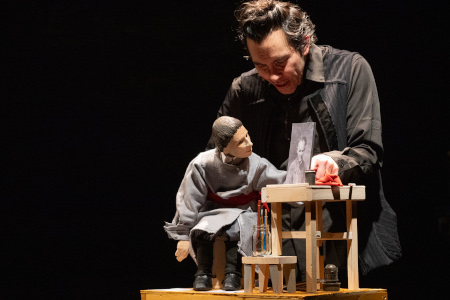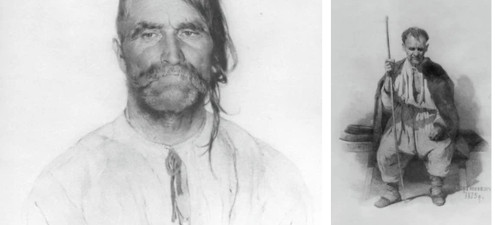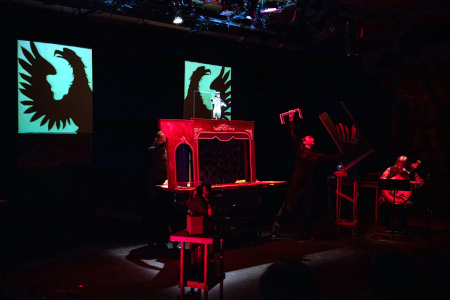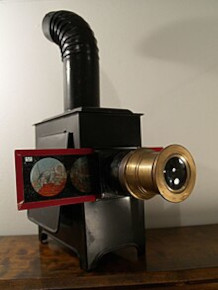
Mindy Aloff
|
The Yara Arts Group, in residence at La Mama E.T.C., is producing an exquisite, though strenuously complex seventy-minute, multi-media show through March 16th in La Mama’s Downstairs theater. As you can surmise from the credits above, it showcases spoken-word theater and poetry, instrumental music (on the ancient Ukrainian bandura, a kind of cross between a portable harp and a zither, used to accompany oral epics) and songs, puppetry (both rod puppets and shadow puppets), videos, and, of course, delicate effects of lighting.
A nineteenth-century narrative of a frame tale within a frame tale, possibly within yet another frame tale—the nineteenth century suddenly takes on a prophetic resonance with our world today as referenced by films of apocalyptic natural catastrophes—the events concern an historic concert in an opera house of the Russian empire during 1875, in which inherited oral epics of the Ukraine were introduced to a cosmopolitan audience by the blind singer Ostap Versai (1803—1890), who accompanied himself on the bandura in much the way that Albert Lord described Eastern European oral poets in his landmark study of the Homeric tradition of spontaneously composed epics in The Singer of Tales.
Versai’s renditions of the epics were accompanied by magic-lantern projections of impressively skillful pencil portraits of Ukrainian figures, made by the art student Porfiry Martynovych (1856—1933), the protagonist of The Magic of Light. Copies of some of those drawings are projected at La Mama, too. (The style of almost photographic likeness in portraiture may have been typical of nineteenth-century Slavic art. I inherited a similarly drawn portrait of a family member that had been composed in Lithuania around the end of the nineteenth century by an itinerant artist.)
The tsar at the time, Alexander II, was known for having emancipated Russia’s serfs in 1861; at some point, though, he lost his generous nature, and, as the play tells us, between the 1875 performance and Alexander’s assassination in 1881 the tsar was led to attempt to suffocate Ukraine, making it illegal to speak Ukrainian or to practice the culture of the region. Ukrainians were long accustomed to hardship. The epic song we hear Julian Katasty as Versai sing with his bandura is “The Escape of the Three Brothers from Azov,” which features two brothers sacrificing their third, youngest sibling to the brutal summer, without water, food, a conveyance, or knowledge of how to get home. Boiling alive, he dies of thirst. Like the survivors’ tragic poems in Old English or sixteenth-century Noh plays or the cruel fairytales of Czechoslovakia, which the puppeteer Vít Horejš has embodied often in New York since 1990, when he founded his Czechoslovak American Marionette Theatre, this Ukrainian epic song takes no prisoners in its account of hard choices and extreme misery of existence.
So the content of this production is sobering and unflinching. But the puppets who serve as the messengers of that content are spellbinding vessels of delight. The shadow puppets are relatively simple, but the rod puppets—activated, as in Japanese bunraku puppet theater, by one source of movement in the spine and head and a second source in the gesturing right hand—offer the mesmerizing details of simple actions rendered by carved objects in real space and time that make bunraku a beloved theatrical tradition. The Yara puppets are much smaller than bunraku ones, and so, in the Yara production, each puppet is energized by one puppeteer (unlike bunraku, where three puppeteers are assigned to each puppet). But the marvelous individuation of the heads and long-fingered hands (conceived by Tom Lee, carved by Kevin White) and the doubling of some characters, presented in different sizes to give changing perspectives on them in the unscrolling narrative, is mesmerizing to the imagination.
At one point, there are three versions of the blind singer available
to the audience simultaneously: one is a small puppet playing his
bandura thanks to a puppeteer who is gently covering the musician’s
right hand to help him stroke the instrument, one is a medium-sized
puppet seated in his own, brilliant, bespoke miniature room, and the
third is the actual musician Kytasty, seated on a chair and strumming
his life-sized bandura. Although the rending story of the Three Brothers
ends, like so much of life, wretchedly, these three incarnations of
the singer-storyteller |
| museums | NYTW mail | recordings | coupons | publications | classified |







